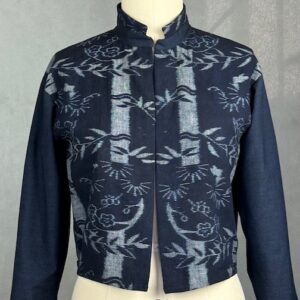
SuMoNo Design / The Oki Doki Anagama Studio: 773 Woods Road, Clermont 12526 | Stairs to studio
theokidokianagama.com | www.sumono.design | kotulak@hotmail.com
Susan is a textile artist. She actively investigates and capitalizes on how the natural properties of materials and processes reveal and enhance surfaces. As she explains:
I spent most of my early life wearing uniforms of one sort or another – first Catholic school jumpers, beanies and clip on bow-tie with saddle shoes, and later the corporate “dress for success” outfit, of blue skirted suits, bow blouses, flesh colored stockings and sensible pumps. I found both stiffling! Kimono fabric turned into fashion is my antidote to boredom, stodginess, blandness and the sameness of commercial attire. It also is my personal dream come true, and a guaranteed preventative, for a woman of a certain age, of becoming invisible!
I learned to sew as a youth, from my mother, who sewed from necessity. The difficulty of finding inspiring fabric at the local stores left me frustrated though. As a young adult I turned my hand to pottery instead, and after several years of doing thrown functional pottery as a hobby, I discovered Raku firing. Raku is one of the lowest termperature firings, and features smoky finishes, crackled glazes and flashes of irridescence. Those finishes give a sense of antiquity, and people comented that my work looked Japanese.
So I started studying Japanese aesthetics, and found it suited me. Fast forward to my retirement from the corporate life, when I wanted to resume sewing “fun” attire. To complete my vision of the kind of attire I wanted to make, I learned how to screen print with dye, and many other techniques for patterning fabric, many of them as used by the Japanese. I sold my first one of a kind hand-printed garments through a store on Madison Avenue NYC, (“across from Armani, next to Via Spiga” I liked to say) and continued to make one of a kind linen jackets for several years.
During that time, I finally took my first trip to Japan. Besides visiting pottery towns, I studied textiles in museums, shops and on people. The temple markets found me knee deep in silk and indigo hemp fabric. Smitten!
Kimono that cost thousands of dollars when originally purchased were being sold at a fraction of their value, it seemed to me. The Japanese (perhaps because of their Shinto background, where objects have spirits) didn’t want to wear any one else’s clothes, no matter how immaculate, how fine, or how well preserved! I began collecting kimono and bolts of fabric in earnest over 10 years ago, both through trips to Japan (sending boxes home by mail almost daily), but also by wending my way from E-bay upstream into the Japanese language websites, and becoming conversant in the absurdly incomprehensible gobblydygook of auto-translation of Japanese idioms and weaving and dying terminology. Here is an example, which I hope you will find as amusing as I do:
Now, years later, I have a collection of fine quality, hand picked kimono (full length) and haori (shorter jacket length) garments that number over a thousand. I confess to being offended when people tell me that I should go to shop at stores here in the USA where they get “bales” of kimono: The quality of the textiles in my collection is of the highest order, and represents an investment in an exhaustive evaluation and selection process for every one of them. I specialize in textiles that are casually elegant, lighthearted but can be worn by women of all ages, and that are stunning and flattering and defy categorization.
My garments are worn by women MC’s at prestidgeous conferences, the editor of a national magazine, at Carnegie Hall by the Doyenne of the orchestra performing, and by fashionable women walking their dogs in chic indigo hemp jackets that go in the machine afterwards.
My rainwear is ideal for travel, being both featherweight and able to be dressed up or down depending on the occasion. I conceived of the design before one of my Japan trips, knowing that along with the Sakura, the spring promised showers. The rainwear has has an easy on easy off hood that eliminated the burden of an umbrella, roomy pockets that elminated carrying a purse, and dolman sleeves that allowed room for a hoodie on the coldest days, and provided plenty of ventilation underarm when the showers passed and the sun came out. After that trip, people kept trying, literally, to buy that jacket off my back!
So I decided that I would like to make them out of my kimono fabric, by laminating them with clear film….Sysyphus, the story goes, rolled the rock up the mountain, daily, and every morning it had rolled back down. It took me 4 years of intermittant efforts to locate a supply of laminate suitable to this project – most of this type of work is done in China in huge factories. Japanese fabric is woven on 14” wide looms. These narrow widths didn’t fit their work flow. I could buy laminating film by the truckload, they said… I ended up extablishing a laminating capability in my own studio and training people to conduct the careful piece-by-piece process.